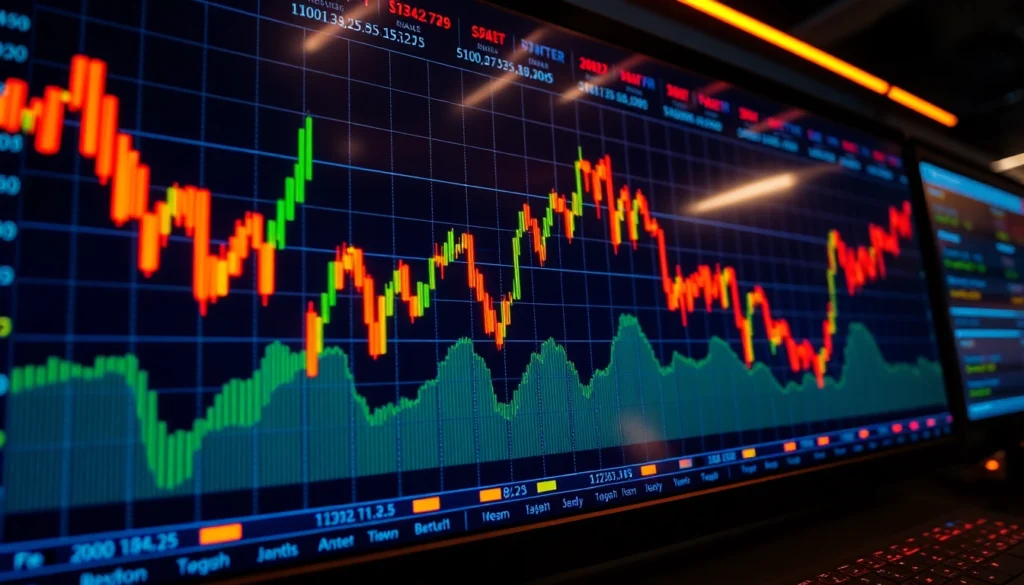
Understanding Current Stock Market Trends
The global financial landscape continues to demonstrate a complex interplay of factors influencing stock market performance. Recently, many indices have shown mixed results, reflecting investor uncertainty amid evolving economic data and geopolitical developments. Despite this volatility, some sectors are exhibiting resilience, offering strategic opportunities for investors seeking to navigate the current environment. For a comprehensive analysis, explore our detailed Stock Market Updates to stay informed about the latest movements and insights.
1.1 Analyzing the Mixed Market Performance
Over the past week, global equities have fluctuated between gains and declines. European stocks, for instance, closed marginally higher, buoyed by defense and technology sectors, while U.S. markets faced pressures from inflation concerns and Federal Reserve policies. The Dow Jones Industrial Average and S&P 500 experienced minor dips, whereas the NASDAQ recovered slightly due to tech sector optimism. Such mixed signals underscore the importance of dissecting sector-specific drivers and regional economic indicators to understand underlying trends.
1.2 Key Factors Influencing Market Fluctuations
Several core factors currently influence market dynamics. Central banking policies, particularly interest rate adjustments and quantitative easing measures, play a pivotal role. The recent U.S. labor market data, indicating employment growth and wage trends, impacts investor sentiment. Geopolitical tensions, such as trade disputes and sanctions, also contribute to volatility. Moreover, commodity prices, notably oil and gold, act as barometers of economic stability, influencing both equity and currency markets.
1.3 Sector-Specific Insights and Opportunities
While some sectors grapple with headwinds, others present growth prospects. Technology continues to innovate with AI integration and digital transformation, potentially boosting growth. Meanwhile, defense stocks remain supported amid geopolitical tensions. Commodities, particularly gold, have surged to new records, reflecting market risk aversion. Recognizing these sector-specific trends allows investors to craft diversified strategies aligned with the evolving economic narrative.
Recent Developments in Gold and Commodities
2.1 Gold Hits New Record Highs – What It Means
The precious metal gold has recently soared past $3,501 an ounce, hitting fresh historic highs. This surge is driven by several factors, including ongoing inflation concerns in the U.S., geopolitical uncertainties, and safe-haven demand from institutional and retail investors alike. Gold’s performance often signals market risk aversion and a hedge against currency devaluation. Its rally indicates that traders and investors are prioritizing stability amid turbulent times.
2.2 Impact of Geopolitical Events on Precious Metals
Geopolitical tensions, such as conflicts in Eastern Europe or US-China trade considerations, tend to elevate gold prices. For instance, recent US advisories on tariffs and policy uncertainties have reinforced gold’s role as a safe haven. Similarly, US and Chinese economic data influence other commodities, shaping supply and demand dynamics. Investors should monitor geopolitical hotspots, as they often trigger short-term surges in precious metals and commodities alike.
2.3 Comparing Gold Performance with Other Commodities
Compared to other commodities like oil, copper, or iron ore, gold’s performance in recent months has been more pronounced, reflecting its unique status during crises. Oil prices, for instance, experienced declines but are still set for weekly gains, influenced by US-China trade relations and US supply adjustments. Iron ore futures, on the other hand, fell amid weak Chinese manufacturing data, illustrating the variability in commodity markets driven by regional economic health. A diversified commodities portfolio can help hedge against sector-specific shocks.
Major Market Movers and Investment Strategies
3.1 Top Performing Stocks and Sectors
In the current climate, some of the best performers include defense stocks, driven by geopolitical tensions, and technology firms adopting innovative AI solutions. Notably, brokerage firms like Robinhood have recently achieved profitability, signaling a potential rebound in fintech. Investors should also watch for emerging opportunities in renewable energy and evolving sectors like digital currencies, which continue to attract institutional interest.
3.2 Strategies for Navigating Market Volatility
Given the volatility, employing risk mitigation tactics is essential. Diversification across sectors and asset classes remains crucial. Investors might consider using tactical asset allocation, shifting holdings based on macroeconomic signals, or employing options strategies to hedge investments. Maintaining a long-term perspective helps withstand short-term fluctuations, especially as markets respond to high-frequency news and geopolitical shifts.
3.3 Timing Trades: Use of Technical Indicators
Technical analysis plays a vital role in timing market entries and exits. Observing trendlines, moving averages like the 200-week trendline for cryptocurrencies, and momentum indicators can provide actionable signals. For instance, Bitcoin’s potential to go ‘full bull’ hinges on critical technical thresholds. Traders should combine technical insights with macroeconomic data to optimize decision-making.
The Role of Macroeconomic Data in Market Predictions
4.1 U.S. Labour Data and Its Market Impact
Recent U.S. labor reports indicate sustained employment growth, but questions surrounding wage increases and participation rates influence Federal Reserve decisions. Strong employment figures could, paradoxically, limit rate cuts, while weaker data might prompt monetary easing. These movements directly impact equity markets and exchange rates, underscoring the importance of real-time labour market analysis for traders.
4.2 Currency Movements and International Trade
Currency fluctuations affect global trade dynamics. For example, the dropping dollar, ahead of US labor data, signals expectations of potential rate adjustments, influencing import-export prices and corporate earnings. The euro’s slight uptick and the Japanese yen’s movement also reflect regional economic perspectives, impacting multinational companies and commodities priced in USD.
4.3 Monitoring Central Bank Policies and Interest Rates
Central banks worldwide, notably the Federal Reserve and Bank of England, continue to influence markets through policy signals. Recent statements warn of potential rate hikes or cuts, affecting bond yields, stock valuations, and currency strength. Keeping an eye on central bank communications and scheduled meetings is critical for strategic positioning.
Future Outlook and Expert Predictions
5.1 Forecasts for Stock Market Direction
Market forecasts indicate cautious optimism, with analysts noting the possibility of sustained volatility. Some experts suggest that markets could exhibit resilience if inflation moderates and geopolitical risks diminish. However, external shocks or unexpected policy shifts could sway markets toward downturns, emphasizing the need for agility and continuous monitoring.
5.2 Emerging Opportunities in Trading and Investment
Emerging themes include digital assets, green energy stocks, and advanced AI applications in finance. The rapid evolution of the cryptocurrency sector, buoyed by new institutional involvement, opens avenues for strategic entry points. Additionally, sectors such as infrastructure and cybersecurity are poised for growth amid increasing digital transformation efforts.
5.3 Preparing for Upcoming Market Challenges
Preparation involves robust risk management strategies, staying informed through real-time data, and maintaining liquidity for opportunity capture. Investors should diversify globally, hedge currency risks, and adopt flexible trading plans to adapt swiftly to unexpected shifts. Understanding macroeconomic indicators and geopolitical developments will be vital in navigating future uncertainties effectively.



